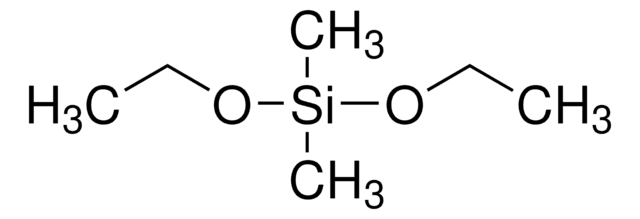371890
3-Aminopropyl(diethoxy)methylsilane
97%
Synonyme(s) :
3-(Diethoxymethylsilyl)propylamine, 3-Aminopropyl-methyl-diethoxysilane
About This Item
Produits recommandés
Niveau de qualité
Essai
97%
Forme
liquid
Indice de réfraction
n20/D 1.426 (lit.)
pb
85-88 °C/8 mmHg (lit.)
Densité
0.916 g/mL at 25 °C (lit.)
Chaîne SMILES
CCO[Si](C)(CCCN)OCC
InChI
1S/C8H21NO2Si/c1-4-10-12(3,11-5-2)8-6-7-9/h4-9H2,1-3H3
Clé InChI
HXLAEGYMDGUSBD-UHFFFAOYSA-N
Vous recherchez des produits similaires ? Visite Guide de comparaison des produits
Application
- Amino Surface Modification and Fluorescent Labelling of Porous Hollow Organosilica Particles: Optimization and Characterization.: This study showcases the effectiveness of 3-Aminopropyl(diethoxy)methylsilane in modifying the surface properties of porous hollow organosilica particles, enhancing their application in biosensing and drug delivery systems. The modification process improves particle stability and functionality, demonstrating the compound′s utility in high-performance biomedical applications (Al-Khafaji et al., 2022).
- Superelastic Multifunctional Aminosilane-Crosslinked Graphene Aerogels for High Thermal Insulation, Three-Component Separation, and Strain/Pressure-Sensing Arrays.: This research highlights the role of 3-Aminopropyl(diethoxy)methylsilane in producing graphene aerogels with exceptional properties such as elasticity, durability, and multi-functionality. These aerogels are promising for thermal insulation, filtration, and as sensors in automotive and aerospace industries, showcasing the compound′s broad potential in advanced material applications (Zu et al., 2019).
- Improving the Gas-Separation Properties of PVAc-Zeolite 4A Mixed-Matrix Membranes through Nano-Sizing and Silanation of the Zeolite.: Utilizing 3-Aminopropyl(diethoxy)methylsilane for the surface modification of Zeolite 4A, this study enhances the gas-separation efficiency of PVAc-zeolite mixed-matrix membranes. The research addresses significant challenges in membrane-based separation technologies, particularly in the purification processes critical for environmental and industrial applications (Esmaeili et al., 2019).
Mention d'avertissement
Danger
Mentions de danger
Classification des risques
Skin Corr. 1B
Code de la classe de stockage
8A - Combustible corrosive hazardous materials
Classe de danger pour l'eau (WGK)
WGK 3
Point d'éclair (°F)
185.0 °F - closed cup
Point d'éclair (°C)
85 °C - closed cup
Équipement de protection individuelle
Faceshields, Gloves, Goggles, type ABEK (EN14387) respirator filter
Faites votre choix parmi les versions les plus récentes :
Déjà en possession de ce produit ?
Retrouvez la documentation relative aux produits que vous avez récemment achetés dans la Bibliothèque de documents.
Les clients ont également consulté
Articles
Mesoporous Oxides and Their Applications to Hydrogen Storage
Notre équipe de scientifiques dispose d'une expérience dans tous les secteurs de la recherche, notamment en sciences de la vie, science des matériaux, synthèse chimique, chromatographie, analyse et dans de nombreux autres domaines..
Contacter notre Service technique

![N-[3-(Trimethoxysilyl)propyl]ethylenediamine 97%](/deepweb/assets/sigmaaldrich/product/structures/149/508/f87a9a89-f138-4c5e-9fe0-6561914241c3/640/f87a9a89-f138-4c5e-9fe0-6561914241c3.png)









